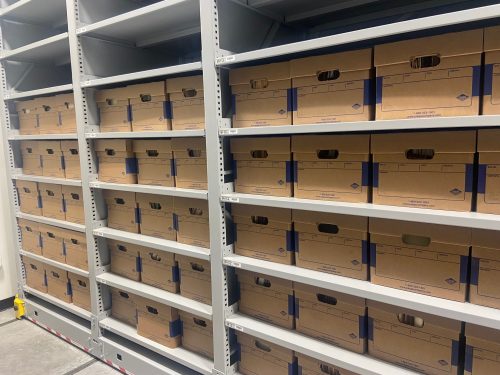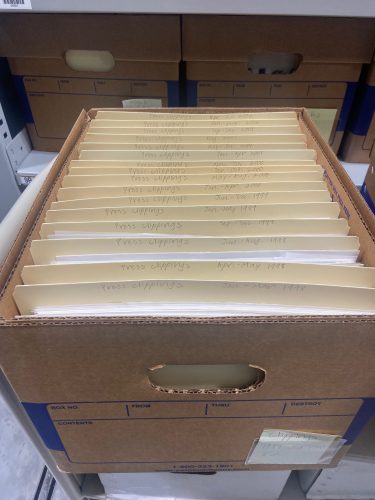
It’s time for another Richard Burr Collection processing update! In my previous blog post, I described the first steps of this massive project: taking an initial inventory of the entire collection and writing the processing plan which will guide the next two years of the project. Since that update, I have been busy processing the collection. This has been a long, difficult, but ultimately rewarding process. As of December 2023, I have finished the processing of three series in the collection: administrative and personal files, legislative files, press files.
Each series has presented me with unique challenges. Press files and administrative and personal files both required some intensive arrangement work in order for them to be usable for researchers. Press files had to be arranged first by format–this series includes both paper files and video and audio tapes–and then chronologically. There were also a lot of duplicated news clippings that could be discarded. For the administrative and personal files, I arranged them based on record type. This series was the most diverse in terms of record type. It includes personal correspondence, invitations, speeches, elementary school work, and documentation of Burr’s time as a football player for Wake Forest–and many, many other types of records as well! In addition to the arrangement work, I was also doing standard archival processing tasks like housing items in archival folders and boxes, removing rubber bands or other materials posing a preservation concern, and giving folders clear labels describing the contents. Both of these series were smaller series, so I worked on them first to get them out of the way before focusing on larger and more difficult tasks.

The biggest challenge I faced was the legislative files series. It is the largest series in the collection–before processing, it contained 180 boxes. It is also arguably the most important series in the collection because it documents Richard Burr’s legislative activities in Congress. Because of this, I wanted the description for this series to be as comprehensive as possible. I decided to focus on description rather than arrangement because rearranging 180 boxes was just too daunting of a task, even with a 2-3 year timeframe. The end result of this description work was a comprehensive folder list for every box in the series. This way, researchers will be able to search the folder list for topics that they are interested in and find the relevant folders–even if they are scattered in multiple boxes across the collection.
One of the gems I have found in this collection is a series of VHS tapes containing an educational talk show filmed by Richard Burr in his early years in Congress. Episodes include interviews with other members of Congress about educational topics relating to government. With the help of Barry Davis, Melde Rutledge, and AV Geeks in Raleigh, NC, we have been able to digitize these tapes and make them available online as part of the digital Richard Burr Collection. It is beyond exciting to have a portion of the collection open for research!
As for what’s next, I have started to work on the final two series in the collection: constituent files and memorabilia. Memorabilia will be particularly challenging because I will be finding storage for a variety of different objects, each with different sizes and preservation needs. Lastly, I will work on the electronic files that we have received from the Burr office, which includes a large photograph archive and some additional legislative files.

7 Comments on ‘Richard Burr Collection Processing Update’
Great job doing this work, Kate! 🙂
Processed collections are a feast for the eyes, and a boon for researchers. Kate, thank you for all your work making the physical collection available and building up the digital collection!
I am so impressed with the progress you are making on this collection!
The collection contains elementary school work? That is comprehensive! Thanks for doing the detailed work of organizing, assessing, and describing all of this rich content!
Sounds like substantial progress, especially to have some digital material available for use already!
Thank you for this great update! I was just talking with alumni yesterday in DC and they asked about this … I just sent them this link so they can read and follow the progress.
Thanks for sharing — I appreciate your informative updates!